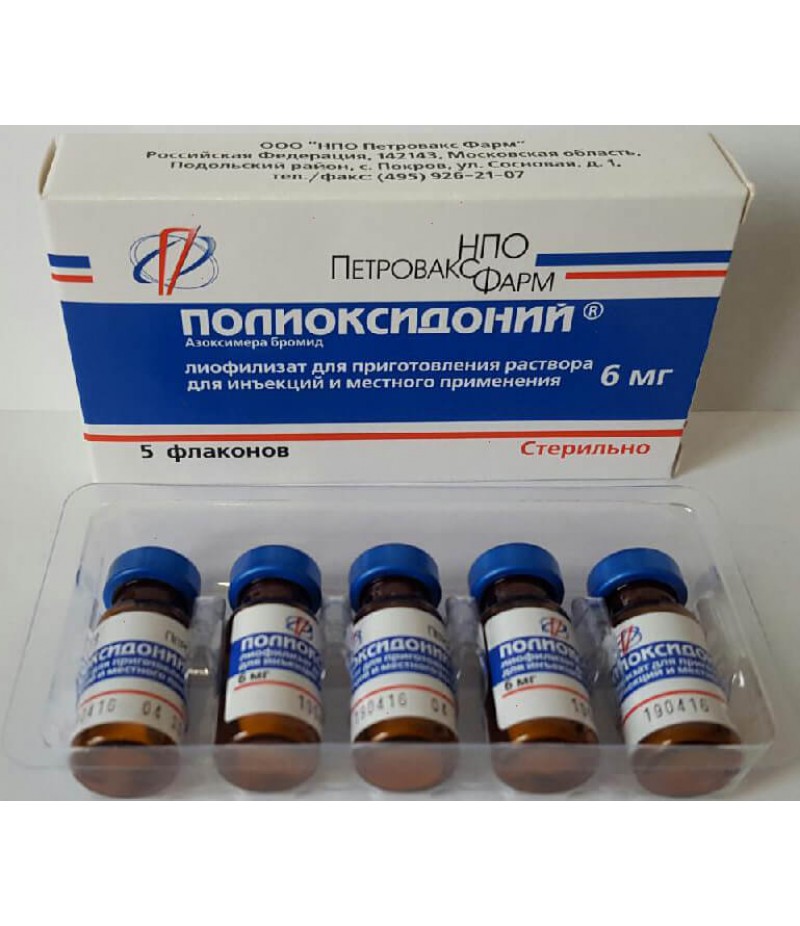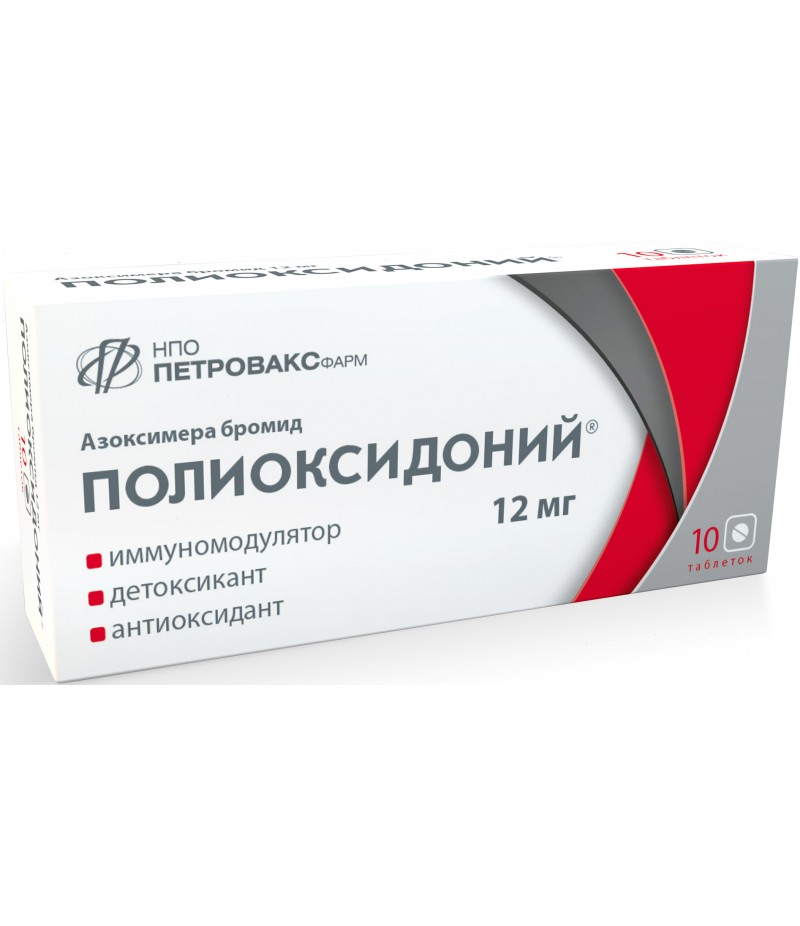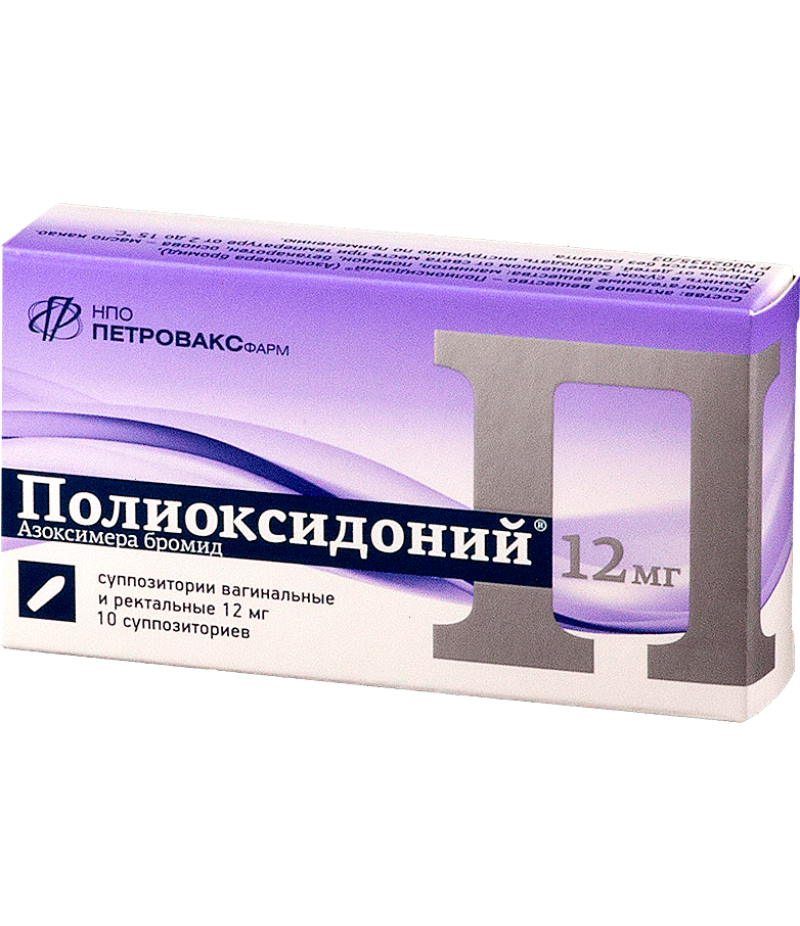Polyoxidonium powder for injections 6mg #5
- $45.80
- 2 or more $44.60
- 3 or more $43.99
- Availability:In Stock
Polyoxidonium powder for injections user manualYou can buy Polyoxidonium powder for injections on this pageComposition per 1 bottle:Active ingredient: Azoxime bromide - 3 mg or 6 mg;Excipients: mannitol - 0.9 mg, povidone K 17 - 0..
Tags: powder
Polyoxidonium powder for injections user manual
You can buy Polyoxidonium powder for injections on this page
Composition per 1 bottle:
Active ingredient: Azoxime bromide - 3 mg or 6 mg;
Excipients: mannitol - 0.9 mg, povidone K 17 - 0.6 mg (for a dosage of 3 mg); mannitol - 1.8 mg, povidone To 17 - 1.2 mg (for a dosage of 6 mg).
Description:
porous mass of white with a yellowish tinge.
Pharmacotherapeutic group:
immunomodulating agent.
ATX code: [L03]
Pharmacological properties
Pharmacodynamics
Azoximer bromide has a complex action: immunomodulating, detoxifying, antioxidant, moderate anti-inflammatory.
The basis of the mechanism of immunomodulatory action of Azoxymer bromide is a direct effect on phagocytic cells and natural killers, as well as stimulation of antibody formation, the synthesis of interferon-alpha and interferon-gamma.
The detoxification and antioxidant properties of the azoxime bromide are largely determined by the structure and high molecular weight of the preparation. Azoximer bromide increases the body's resistance to local and generalized infections of bacterial, fungal and viral etiology. Restores immunity to secondary immunodeficiency conditions caused by various infections, traumas, complications after surgery, burns, autoimmune diseases, malignant neoplasms, the use of chemotherapeutic agents, cytostatics, steroid hormones.
A characteristic feature of Azoxymer bromide in local (intranasal, sublingual) application is the ability to activate the early defense factors of an organism from infection: the drug stimulates the bactericidal properties of neutrophils, macrophages, enhances their ability to absorb bacteria, increases the bactericidal properties of saliva and the secretion of the mucosal upper respiratory tract.
Azoximer bromide blocks soluble toxic substances and microparticles, has the ability to excrete toxins from the body, salts of heavy metals, inhibits lipid peroxidation, both by interception of free radicals and by elimination of catalytically active Fe2 + ions. Azoximer bromide reduces the inflammatory response by normalizing the synthesis of pro- and anti-inflammatory cytokines.
Azoximer bromide is well tolerated, does not have mitogenic, polyclonal activity, antigenic properties, does not have allergic, mutagenic, embryotoxic, teratogenic and carcinogenic effects. Azoxime bromide
has no smell and taste, does not have a local irritant effect when applied on the mucous membranes of the nose and oropharynx.
Pharmacokinetics
Azoximer bromide is characterized by rapid absorption and a high rate of distribution in the body. The maximum concentration of the drug in the blood with intramuscular injection is reached after 40 minutes. The half-life period for different ages is from 36 to 65 hours. Bioavailability of the drug is high: more than 90% with parenteral administration.
Azoximer bromide is quickly distributed to all organs and tissues of the body, penetrates through blood-brain and hemato-ophthalmic barriers. There is no cumulative effect. In the body of Azoximer, bromide is biodegraded to low molecular weight oligomers, excreted mainly by the kidneys, with feces - not more than 3%.
Indications for use
It is used in adults and children from 6 months for treatment and prevention of infectious and inflammatory diseases (viral, bacterial and fungal etiology), in the stage of exacerbation and remission.
For the treatment of adults (in complex therapy):
chronic recurrent infectious-inflammatory diseases of different localization, bacterial, viral and fungal etiology in the stage of exacerbation;
acute viral, bacterial infections of the ENT organs, upper and lower respiratory tract, gynecological and urological diseases;
acute and chronic allergic diseases (including pollinosis, bronchial asthma, atopic dermatitis), complicated by a bacterial, viral and fungal infection;
malignant tumors during and after chemo- and radiotherapy to reduce immunosuppressive, nephro- and hepatotoxic effects of drugs;
generalized forms of surgical infections; for activation of regenerative processes (fractures, burns, trophic ulcers);
Rheumatoid arthritis, complicated by bacterial, viral and fungal infection, against long-term use of immunosuppressants;
pulmonary tuberculosis.
For treatment of children older than 6 months (in complex therapy):
acute and exacerbation of chronic inflammatory diseases of any localization (including ENT organs - sinusitis, rhinitis, adenoiditis, pharyngeal tonsillitis hypertrophy, ARVI) caused by pathogens of bacterial, viral, fungal infections;
acute allergic and toxic-allergic conditions, complicated by a bacterial, viral and fungal infection;
A bronchial asthma complicated by chronic infections of the respiratory tract;
atopic dermatitis, complicated by a purulent infection;
intestinal dysbiosis (in combination with specific therapy).
For prevention (monotherapy) in children older than 6 months and adults:
influenza and ARVI;
postoperative infectious complications.
Contraindications
Increased individual sensitivity;
Pregnancy, the period of breastfeeding;
Children up to 6 months;
Acute kidney failure.
Carefully
- chronic renal failure (not used more than 2 times a week).
Application in pregnancy and during breastfeeding
Contraindicated the use of the drug Polyoxidonium powder pregnant women and women during breastfeeding (clinical experience is not available).
The experimental study of Polyoxidonium powder in animals showed no effect on the generative function (fertility) of males and females, embryotoxic and teratogenic effects, effects on fetal development, both with the introduction of the drug during the entire pregnancy, and during lactation.
Dosing and Administration
Methods of using the preparation Polyoxidonium powder: parenteral, intranasal, sublingual.
The methods of application, the dosage regimen, the need and the frequency of the subsequent courses of therapy are chosen by the doctor depending on the severity of the disease and the age of the patient.
Preparation of solutions for parenteral administration (intramuscularly and intravenously):
For intramuscular injection, Polyoxidonium 3 mg is dissolved in 1 ml (a dose of 6 mg in 2 ml) of water for injection or 0.9% solution of sodium chloride. After applying the solvent, the drug is left for 2-3 minutes for swelling, then mixed with rotational movements, without shaking.
For intravenous drip, the preparation Polyoxidonium powder is dissolved in 2 ml sterile 0.9% sodium chloride solution. After applying the solvent, the drug is left for 2-3 minutes for swelling, then rotational movements are mixed. The dose calculated for the patient is sterile transferred to a vial / bag with 0.9% sodium chloride solution.
The prepared solution for parenteral administration is not subject to storage.
Preparation of solution for intranasal and sublingual administration:
for children, a dose of 3 mg is dissolved in 1.0 ml (20 drops), a dose of 6 mg in 2.0 ml (40 drops) (in one drop (0.05 ml) of the prepared solution contains 0.15 mg of the preparation);
for adults, a dose of 6 mg is dissolved in 1.0 ml (20 drops) of distilled water, 0.9% sodium chloride solution or boiled water at room temperature.
Dosing and Administration in Adults
Parenteral (intramuscular or intravenous): the drug is prescribed to adults in doses of 6-12 mg once a day, every other day or 1-2 times a week, depending on the diagnosis and severity of the disease.
In acute viral and bacterial infections of the ENT organs, upper and lower respiratory tract, gynecological and urological diseases: 6 mg daily for 3 days, then a day later with a course of 10 injections.
With chronic relapsing infectious and inflammatory diseases of different locations, bacterial, viral and fungal etiology, in the acute stage: 6 mg every other day 5 injections, then 2 times a week with a course of 10 injections.
In acute and chronic allergic diseases (including pollinosis, bronchial asthma, atopic dermatitis), complicated by a bacterial, viral and fungal infection: 6-12 mg, a course of 5 injections.
With rheumatoid arthritis, complicated by bacterial, viral and fungal infection, against the background of long-term use of immunosuppressants: 6 mg every other day 5 injections, then 2 times a week with a course of 10 injections.
In generalized forms of surgical infections: 6 mg daily for 3 days, then a day later with a course of 10 injections.
To activate regenerative processes (fractures, burns, trophic ulcers): 6 mg for 3 days, then every other day, with a course of 10 injections.
For the prevention of postoperative infectious complications: 6 mg every other day 5 injections.
With pulmonary tuberculosis: 6 mg twice a week with 20 injections.
In cancer patients:
- before and against the background of chemotherapy to reduce the immunosuppressive, hepato- and nephrotoxic effect of chemotherapeutic agents at 6 mg every other day by the course
10 injections; further the frequency of administration is determined by the doctor, depending on the tolerability and duration of chemotherapy and radiation therapy;
- for the prevention of immunosuppressive effects of the tumor, for the correction of immunodeficiency after chemo- and radiotherapy, after surgical removal of the tumor, prolonged use of the preparation Polyoxidonium (2-3 months to 1 year) 6 mg 1-2 times a week is shown. With the appointment of a long course, there is no cumulation effect, manifestations of toxicity and addiction.
Intranasal appoint 6 mg per day (3 drops in each nasal passage 3 times a day - for 10 days):
- for treatment of acute and exacerbations of chronic infections of ENT organs;
- to strengthen the regenerative processes of the mucous membranes;
- for the prevention of complications and relapses of chronic diseases;
- for the prevention of influenza and ARVI.
Dosage and administration in children
Methods of application of the preparation Polyoxidonium: parenteral, intranasal and sublingual. The methods of application are chosen by the doctor depending on the severity of the disease and the age of the patient.
Parenteral (intramuscular or intravenous): prescribe to children from 6 months in a dose of 0.1-0.15 mg / kg daily, every other day or twice a week with a course of 5-10 injections.
Intranasal and sublingual: daily at a daily dose of 0.15 mg / kg up to 10 days.
The drug is administered 1-3 drops in one nasal passage or under the tongue with an interval of at least 1-2 hours, in 2-3 hours per day.
In one drop (0.05 ml) of the prepared solution contains 0.15 mg of the preparation.
At a body weight of the child more than 20 kg, the calculation of the daily dose is based on 1 drop per 1 kg of body weight, but not more than 40 drops (6 mg of active substance).
The prepared solution for intranasal and sublingual administration can be stored at room temperature in the manufacturer's packaging for up to 48 hours.
Recommended treatment regimens in children:
Parenteral:
In acute and exacerbation of chronic inflammatory diseases of any localization (including ENT organs - sinusitis, rhinitis, adenoiditis, pharyngeal tonsillitis hypertrophy, acute respiratory viral infection) caused by pathogens of bacterial, viral, fungal infections: 0.1 mg / kg 3 days successively, then through the day with a course of 10 injections.
In acute allergic and toxic-allergic conditions (including bronchial asthma, atopic dermatitis), complicated by bacterial, viral and fungal infection: intravenously drip at a dose of 0.1 mg / kg, 3 days daily, then every other day, with a course of 10 injections in combination with basic therapy.
Intranasally: every day 1-2 drops in each nasal passage 3 times a day by the course up to 10 days (see calculation of the daily dose of the preparation for intranasal and sublingual administration in Table 1):
With acute and chronic rhinitis, rhinosinusitis, adenoiditis (treatment and prevention of exacerbations);
For preoperative preparation of patients with surgical interventions for ENT pathology, and also in the postoperative period with the purpose of preventing infectious complications or relapses of the disease;
Treatment and prevention of influenza and other ARVI (within 1 month before the expected epidemic), at any time after the onset of the disease and during the period of convalescence);
Sublingually, children of early, preschool and primary school age: daily at a daily dose of 0.15 mg / kg in 2 divided doses for 10 days:
With adenoiditis, hypertrophy of the tonsils: (as a component of conservative treatment);
For preoperative preparation and postoperative rehabilitation;
For seasonal prevention of exacerbations of chronic foci of infections of the oropharynx, upper respiratory tract, inner and middle ear;
For the treatment of intestinal dysbacteriosis (in combination with basic therapy) for 10 days.
Side effect
When using Polyoxidonium injections, the following general and local reactions occurred:
Not often (≥1 / 1000 to <1/100): at the site of introduction - tenderness, redness and denseness of the skin.
Very rarely (≥1 / 10,000): fever to 37.3 ° C, mild anxiety, chills in the first hour after the injection, allergic reactions.
Overdose
Cases of overdose are not registered.
Interaction with other drugs
Azoximer bromide does not inhibit isoenzymes CYP1A2, CYP2S9, CYP2S19, CYP2D6, cytochrome P-450, therefore the drug is compatible with many drugs, including antibiotics, antiviral, antifungal and antihistamine drugs, glucocorticosteroids and cytostatics.
special instructions
When developing an allergic reaction, discontinue the use of the drug Polyoxidonium injections and consult a doctor.
If it is necessary to stop taking Polyoxidonium injections, the cancellation can be done immediately, without a gradual dose reduction.
If you miss the introduction of a regular dose of the drug, its subsequent use should be carried out as usual, as indicated in this manual or recommended by a doctor. The patient should not enter a doubled dose to compensate for missed doses.
Do not use the drug in the presence of visual signs of its unfitness (defect packaging, change the color of the powder).
When painful at the injection site, the drug is dissolved in 1 ml of a 0.5% solution of procaine (novocaine) in the absence of increased individual sensitivity to procaine (novocaine). When intravenous (drip) administration should not be dissolved in protein-containing infusion solutions.
Impact on the ability to drive vehicles and mechanisms
The use of Polyoxidonium powder does not affect the ability to perform potentially dangerous activities requiring increased concentration of attention and speed of psychomotor reactions (including driving, working with moving mechanisms).
Form of issue
Liofilizate for solution for injection and topical application, 3 mg, 6 mg.
For 4.5 mg of the drug (for a dosage of 3 mg) or 9 mg of the drug (for a dosage of 6 mg) in bottles of glass 1 of hydrolytic class, hermetically sealed with rubber stoppers and crimped with aluminum caps.
5 vials of the drug in a contour mesh package made of a polyvinyl chloride film. One contour pack together with the instruction for use is placed in a pack of cardboard or 5 bottles together with the instructions for use are placed in a pack of cardboard with an insert from the cardboard.
For 50 bottles (for hospitals) with the drug along with 50 instructions for use are placed in a box with cardboard partitions.
Shelf life - 2 years. Do not use after expiry date.
Storage conditions
In a dry place at a temperature of 2 to 8 ° C. Keep out of the reach of children.
Terms of sell
You don't need a prescription to buy Polyoxidonium for injections.



